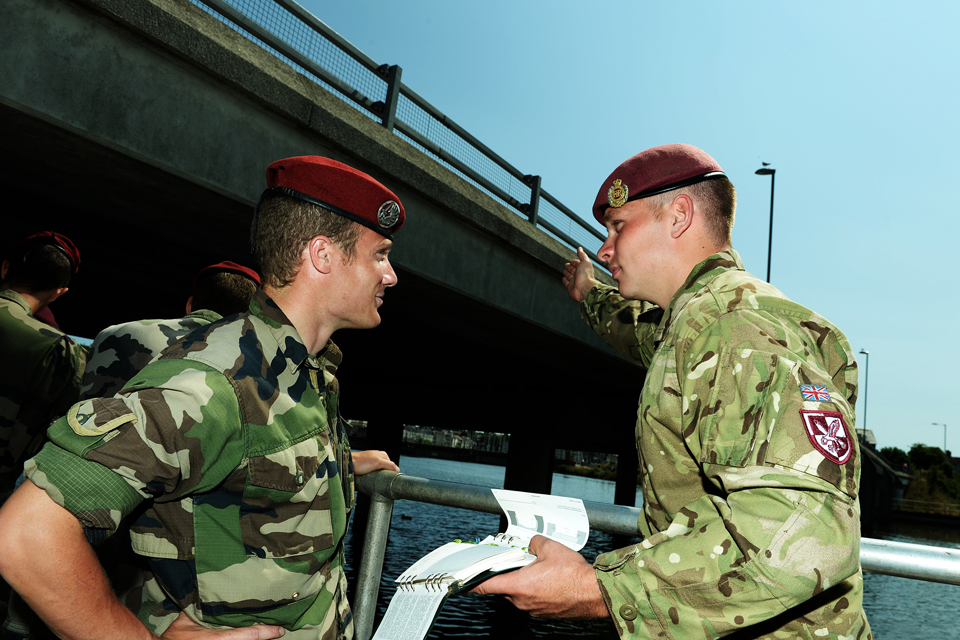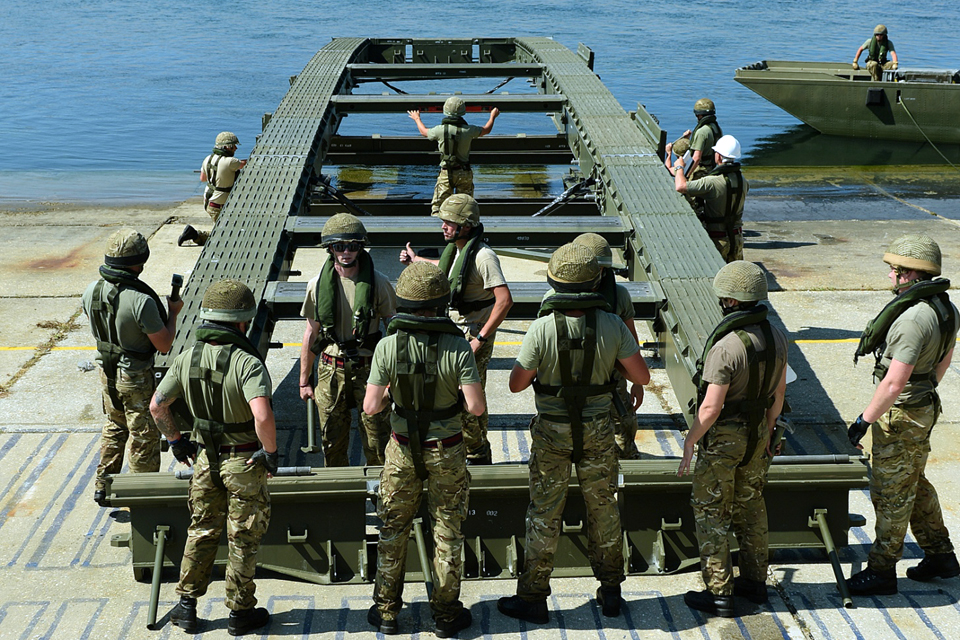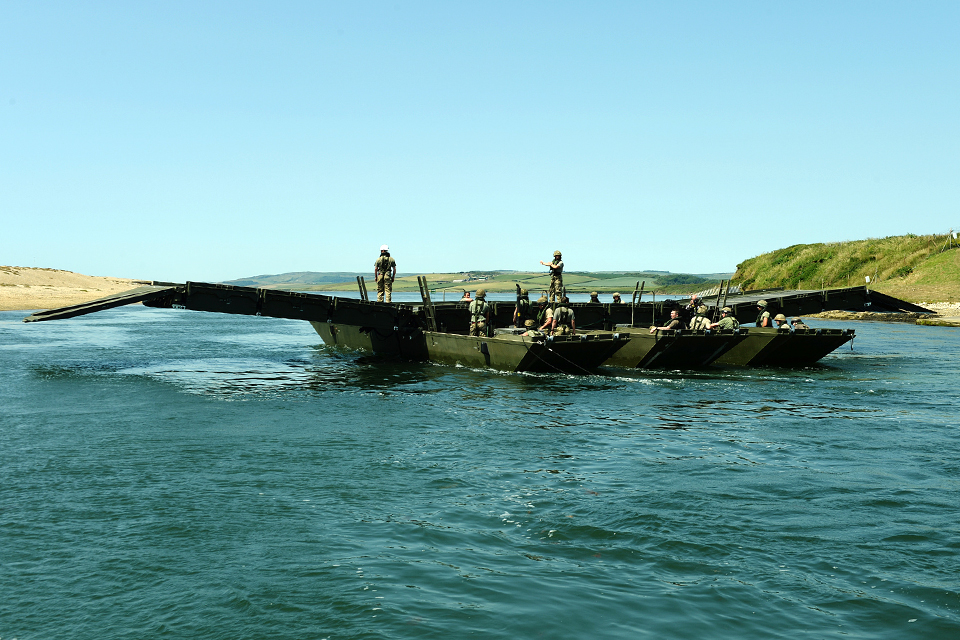British and French troops in bridging master class
UK airborne engineers joined French paratroopers on a bridge building exercise to prepare them to respond to urgent operations worldwide.
![British airborne engineers deploying a 100-foot Medium Girder Bridge [Picture: Corporal Obi Igbo, Crown copyright]](https://assets.publishing.service.gov.uk/media/5a612ae540f0b65266e7e032/s300_16x-2013-063-0761.JPG)
British airborne engineers deploying a 100-foot Medium Girder Bridge
Military engineers of 23 Engineer Regiment (Air Assault) (23 Engr Regt (Air Asslt)), based at Woodbridge in Suffolk, recently spent 2 weeks on Exercise Eagle Sapper at Wyke Regis Training Area in Dorset.
The exercise saw the sappers hone their skills alongside reservists from 299 Parachute Squadron Royal Engineers (Volunteers) and French troops from 17e Régiment de Génie Parachutiste (17e RGP).
The troops were tested across a range of skills, from assessing the capacity of existing crossings to constructing bridges across fast-flowing water and deep gaps.

Lieutenant Colonel Jason Hones, Commanding Officer of 23 Engineer Regiment (Air Assault), watches the construction of a 100-foot Medium Girder Bridge [Picture: Corporal Obi Igbo, Crown copyright]
Bridging is a key aspect of 23 Engr Regt (Air Asslt)’s role providing close combat engineering support to the Air Assault Task Force (AATF), which sees 16 Air Assault Brigade maintain a force ready to deploy anywhere in the world at short notice for operations from disaster relief to war fighting.
The training ranged from setting up a Medium Girder Bridge, capable of carrying a Challenger 2 main battle tank across a 30 metre deep and 30 metre wide gap, to taking to the streets of Weymouth to assess which military vehicles could use the town’s bridges.
Crossing the tidal waters of the Fleet, sandwiched between the shore and Chesil Beach, was a stern test for sappers setting up an Air Portable Ferry Bridge (APFB). APFB can be parachuted or moved by helicopter and set up either as a conventional bridge or a self-propelled ferry to cross wider obstacles.

British and French Airborne Engineers train in bridge site reconnaissance [Picture: Corporal Obi Igbo, Crown copyright]
Staff Sergeant Kieran Dale was in charge of the build, with APFB designed to be set up by 24 men in 2 hours and carry a 35-tonne load. He said:
AFPB is very flexible and capable kit, but setting it up in a strong current is a real challenge. The ferry is built on the water and it’s very important to ensure the parts are correctly aligned, which is hard when the current is moving everything around.
Among the 20 reservists on the exercise was Sapper Nathan Gibson from South Shields, a medical electronics technician in civilian life.
The 26-year-old has been in 299 Para Sqn RE (V), which is the only parachute-trained engineer unit in the Army Reserve, for 18 months.

British Army sappers prepare to set up an Air Portable Ferry Bridge [Picture: Corporal Obi Igbo, Crown copyright]
Sapper Gibson said:
I’ve always been interested in the military and joined up to challenge myself. This is my first major exercise and it’s great to get out and do practical engineering tasks. The training is really well done and we’ve been treated the same as the Regulars.
The skills I’m learning don’t directly relate to my job, but the wider experience I’m getting does. What I’ve learnt about teamwork and pulling together in uncomfortable situations has really developed my confidence at work.
Parallel to bridging activity, the Regiment’s dive team was put through its paces in joint training with 17e RGP’s divers. In the waters of Portland Harbour the divers practised surveying underwater structures, clearing obstacles using hydraulic tools and search tasks.
The French engineers, who were divers and reconnaissance specialists, joined the exercise to learn about British equipment and techniques to be ready to deploy together as part of the Combined Joint Expeditionary Force, a partnership between 16 Air Assault Brigade and 11e Brigade Parachutiste (11e BP) for contingency operations.

Airborne Sappers launch an Air Portable Ferry Bridge [Picture: Corporal Obi Igbo, Crown copyright]
Lieutenant Colonel Jason Hones, Commanding Officer of 23 Engr Regt (Air Asslt), said:
This exercise has been an excellent opportunity to work with the Regiment’s integrated reserve squadron and our French counterparts.
The Weymouth area is a tourist destination but this has been anything but a holiday for my sappers. We have worked extremely hard to practise and refine our techniques, particularly in the key mobility skill of bridging, to prepare for potential deployments as part of the Air Assault Task Force.